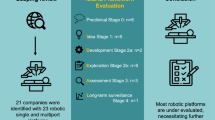Abstract
A pilot study of uterine and vaginal vault manipulation using a new surgical robot—The ViKY Uterine Positioner™––enrolled 36 cases comprising 31 hysterectomies, two myomectomies, two sacrocolpopexies and one excision of severe endometriosis performed between July 2010 and February 2012 in a tertiary referral District General Hospital in the UK. Mean age was 48 years, body mass index 25.7 kg/m2 and uterine weight 231 g. Nine cases were foot-controlled and 27 by Bluetooth voice control. ViKY UP™ docking time once V-Care™ was inserted was 4.3 min. The device caused no peri-operative complications. Adequate mobilization, visualization and range of movement was possible in 81, 78 and 61 % of cases, respectively, with most of the problems arising in cases with uterine weight >350 g. ViKY UP™ was detached and an assistant was required in three cases, whilst V-Care™ came out of the uterus in one case. The learning curve led to various adjustments including optimizing patient position, increasing the device range of movement and adjusting device sensitivity. As a result, problems were minimized in our last nine cases. Adding robotic uterine manipulation is the obvious next step to give the gynecologist the ultimate control and stability of the uterus during robotic-assisted surgery without having to lift their head from the viewfinder or rely on a remotely situated perineal assistant. ViKY UP™ is the first device to deliver this. Pilot study results did not demonstrate compromised safety, and the device appears to be effective and easy to learn.




Similar content being viewed by others
References
Gobern JM, Novak CM, Lockrow EG (2011) Survey of robotic surgery training in obstetrics and gynecology residency. J Minim Invasive Gynecol 18(6):755–760
Swan K, Kim J, Advincula AP (2010) Advanced uterine manipulation technologies. Surg Technol Int 20:215–220
Nawfal AK, Orady M, Eisenstein D et al (2011) Effect of body mass index on robotic-assisted total laparoscopic hysterectomy. J Minim Invasive Gynecol 18(3):328–332
Acknowledgments
The work was carried out with educational grant funding from the manufacturer of ViKY UP™, EndoControl™, La Tronche, France and an honorarium was paid to the surgeon by Mantis, UK™.
Conflict of interest
None.
Author information
Authors and Affiliations
Corresponding author
Rights and permissions
About this article
Cite this article
Akrivos, N., Barton-Smith, P. A pilot study of robotic uterine and vaginal vault manipulation: the ViKY Uterine Positioner™. J Robotic Surg 7, 371–375 (2013). https://doi.org/10.1007/s11701-013-0406-3
Received:
Accepted:
Published:
Issue Date:
DOI: https://doi.org/10.1007/s11701-013-0406-3




